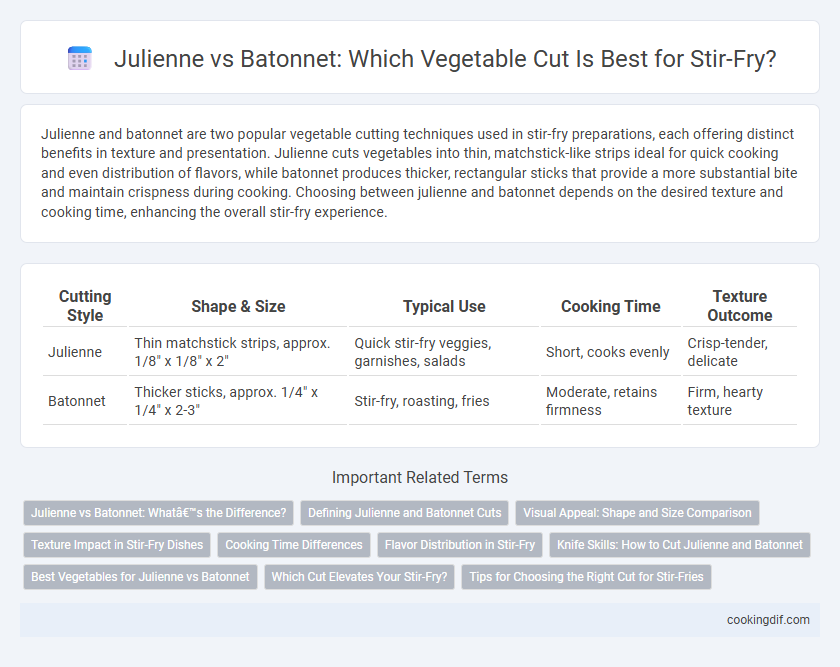Julienne and batonnet are two popular vegetable cutting techniques used in stir-fry preparations, each offering distinct benefits in texture and presentation. Julienne cuts vegetables into thin, matchstick-like strips ideal for quick cooking and even distribution of flavors, while batonnet produces thicker, rectangular sticks that provide a more substantial bite and maintain crispness during cooking. Choosing between julienne and batonnet depends on the desired texture and cooking time, enhancing the overall stir-fry experience.
Table of Comparison
| Cutting Style | Shape & Size | Typical Use | Cooking Time | Texture Outcome |
|---|---|---|---|---|
| Julienne | Thin matchstick strips, approx. 1/8" x 1/8" x 2" | Quick stir-fry veggies, garnishes, salads | Short, cooks evenly | Crisp-tender, delicate |
| Batonnet | Thicker sticks, approx. 1/4" x 1/4" x 2-3" | Stir-fry, roasting, fries | Moderate, retains firmness | Firm, hearty texture |
Julienne vs Batonnet: What’s the Difference?
Julienne and batonnet are two precise vegetable cutting techniques distinguished by their dimensions: julienne produces thin, matchstick-sized strips approximately 1/8 inch thick and 2 inches long, ideal for quick, even cooking in stir-fry dishes. Batonnet cuts are thicker, about 1/4 inch square and 2 to 3 inches long, offering a chunkier texture that retains crunch and provides a robust mouthfeel in stir-fried vegetables. Choosing between julienne and batonnet depends on the desired cooking time and texture, where julienne allows faster cooking and delicate crispness, while batonnet ensures a more substantial bite and longer cooking duration.
Defining Julienne and Batonnet Cuts
Julienne is a precise cut producing thin matchstick-like strips measuring approximately 1/8 inch by 1/8 inch by 2 to 2.5 inches, ideal for quick, uniform cooking in stir-fry dishes. Batonnet cuts are thicker rectangular sticks, roughly 1/4 inch by 1/4 inch by 2 to 2.5 inches, offering more texture and a heartier bite in stir-fried vegetables. Choosing between julienne and batonnet impacts cooking time and presentation, with julienne ensuring rapid cooking and batonnet providing a substantial mouthfeel.
Visual Appeal: Shape and Size Comparison
Julienne cuts produce thin, matchstick-sized strips measuring about 1/8 by 2 inches, offering a delicate, elegant look ideal for stir-fry presentations. Batonnet cuts are thicker, approximately 1/4 by 2 to 3 inches, creating a more substantial and rustic appearance in dishes. The slender julienne enhances visual intricacy and cooks quickly, while batonnet provides a bold texture and a sturdier bite.
Texture Impact in Stir-Fry Dishes
Julienne cuts vegetables into thin, matchstick-sized strips that cook quickly and evenly, enhancing a tender-crisp texture ideal for vibrant stir-fry dishes. Batonnet cuts produce thicker, baton-like pieces that maintain more crunch and a substantial bite, adding a satisfying contrast in texture. Choosing between julienne and batonnet shapes allows chefs to control the balance of tenderness and crispness, directly impacting the mouthfeel and overall sensory experience of stir-fried vegetables.
Cooking Time Differences
Julienne cuts vegetables into thin, matchstick-sized strips measuring about 1/8 inch by 2 inches, which results in faster cooking times due to increased surface area and uniform heat exposure during stir-frying. Batonnet cuts are thicker, typically 1/4 inch by 2 to 3 inches, requiring longer cooking times to achieve the same tenderness and even doneness. Choosing julienne over batonnet speeds up stir-fry preparation and ensures crisp-tender texture, essential for maintaining vibrant flavor and color.
Flavor Distribution in Stir-Fry
Julienne cuts produce thin, uniform strips that cook quickly and allow flavors from sauces and spices to penetrate evenly, enhancing the overall taste of the stir-fry. Batonnet cuts are thicker and provide a firmer texture, resulting in slower flavor absorption but a satisfying bite that complements the dish's crunchy elements. Choosing between julienne and batonnet shapes directly influences the balance of texture and flavor distribution in stir-fried vegetables.
Knife Skills: How to Cut Julienne and Batonnet
Mastering knife skills for stir-fry involves precise cutting techniques like julienne and batonnet to ensure even cooking and texture. Julienne produces thin, matchstick-sized strips approximately 1/8 inch by 1/8 inch by 2 inches, ideal for quick cooking and a delicate presentation. Batonnet creates thicker sticks about 1/4 inch by 1/4 inch by 2 to 2.5 inches, offering a sturdier bite and retaining more crunch during high-heat stir-frying.
Best Vegetables for Julienne vs Batonnet
Best vegetables for julienne cuts include carrots, bell peppers, zucchini, and cucumbers due to their firm texture and ability to hold thin, matchstick shapes that cook evenly in stir-fry dishes. Batonnet cuts suit sturdier vegetables like potatoes, celery, and green beans, providing a thicker, uniform stick ideal for maintaining crunchiness and structure under high heat. Choosing the appropriate cut enhances texture balance and visual appeal, optimizing the stir-fry experience.
Which Cut Elevates Your Stir-Fry?
Julienne and batonnet cuts both enhance stir-fry dishes by influencing texture and cooking time, but julienne offers thinner, matchstick-sized strips that cook quickly and evenly, ideal for crisp, tender vegetables. Batonnet cuts, thicker and chunkier, provide a heartier bite and retain more crunch after stir-frying, making them preferable for sturdier vegetables like carrots or bell peppers. Selecting between julienne and batonnet depends on the desired balance of texture and cooking speed to elevate the overall stir-fry experience.
Tips for Choosing the Right Cut for Stir-Fries
Selecting the ideal vegetable cut for stir-fries involves balancing cooking time and texture; julienne cuts, measuring about 1/8 inch by 1/8 inch by 2 to 3 inches, offer quick cooking and a tender crispness ideal for delicate vegetables like bell peppers and carrots. Batonnet cuts, larger at roughly 1/4 inch by 1/4 inch by 2 to 3 inches, provide a meatier texture and hold up well in longer stir-fry cooking or when paired with heartier ingredients such as zucchini or celery. Matching the cut size to the vegetable's density and desired bite ensures uniform cooking and optimal flavor integration in your stir-fry dish.
Julienne vs Batonnet for vegetable cutting Infographic

 cookingdif.com
cookingdif.com